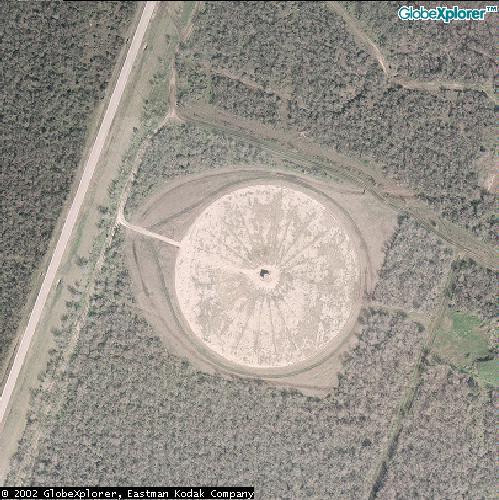16 April 2005. Add Google satellite photo. See new
NSA facility nearby:
http://cryptome.org/eyeball/nsa-sa/nsa-sa-eyeball.htm
22 June 2002. Since this file was presented in April, higher resolution
photographs have become available on MapQuest for closest-in views. They
have been added with overviews of the RSOC area. The munitions bunkers to
the left of the RSOC appears to be the former Medina National Stockpile Site
(NSS), based on the the remnants of a double-fencing security system typical
of nuclear weapons storage areas (WSAs).
From the report
Taking Stock: Worldwide
Nuclear Deployments 1998, by William M. Arkin, Robert S. Norris and
Joshua Handler, published in March 1998 by the
Natural Resources Defense Council.
http://www.nrdc.org/nuclear/tkstock/p53-94.pdf
Texas also hosted two of the original National Stockpile Sites (NSS). Killeen
Base (“Site B”) at Fort Hood, Texas, was the first of the initial
three (with Manzano Base
and Clarksville Base) to receive weapons, in 1948. The second NSS was Medina
Base at Lackland AFB, San Antonio. The original storage area was constructed
between 1953 and 1955. In 1959, the AEC built a Modification Center at Medina
Base for disassembling weapons and storage operations for the military ceased.
On November 13, 1961 an explosion involving 123,000 pounds of chemical high
explosive components of nuclear weapons occurred at Medina. On the southern
boundary of the Medina facility workmen were placing subassemblies from
dismantled atomic bombs in a storage igloo [photo
below]. The subassemblies, which were being stored for
further processing and disposal, contained chemical high explosives, aluminum,
natural and depleted uranium. No longer covered by the metal bomb shell,
the subassemblies were being stored in metal and plastic explosive cases
which had openings on their surfaces leaving the explosive exposed. They
were handled by a three-man crew—two fork lift operators who moved them
from a straddle carrier into the igloo and one man on the carrier.
Most of the load was in the igloo when at about 10:24 the explosive in one
of the subassemblies ignited. Seeing the flash, the drivers sprinted for
cover, alerting the men outside. For about 45 seconds the explosive burned.
Then it detonated with a force of over 60 tons of TNT. The first explosion
set off other subassemblies in the igloo and those still on the carrier.
The igloo disappeared in a cloud of smoke and dust, leaving a crater some
twenty feet deep.
In the 45 seconds between ignition and detonation the three workers got away.
Their injuries were minor. Adjacent igloos were not disturbed. The shock
was felt for miles. Windows were shattered in downtown San Antonio, twelve
miles away. This is one of the 32 acknowledged “Broken Arrows”
or serious nuclear weapon accident confirmed by the Pentagon. The
disassembly/modification work continued at Medina until 1965, when all functions
were transferred to Pantex.
More on active nuclear weapon storage areas:
http://cryptome.org/eyeball/nwsa/nwsa-eyeball.htm
May 1, 2002. B. writes:
"Moyock" is a Naval
Security Group facility: its actual name is Naval Security Group Activity
(NSGA) Northwest. The large circularly disposed antenna array is an AN/FRD-10,
and its purpose is radio interception and high-frequency direction-finding
(HF-DF). The site is or was part of the NSG's BULLSEYE HF-DF net, more recently
called the CROSSHAIR net. According to this note the Northwest array has
recently been dismantled:
http://www.anzwers.org/free/navyscpo/end_of_an_era_nw_va.html
The big circles at Sugar
Grove also used to contain FRD-10s, but I think those ones have been
scrapped too. Many FRD-10 sites have been closed, both in the US and around
the world (the two Canadian sites, Masset and Gander, are still operating,
however). If you want to eyeball the whole US set, I think the current
operational list is NSGA Winter Harbor, MA, NSGA San Diego, CA, NSGA Sabana
Seca, PR, NSGA Wahiawa, HI.
There is also an array of some kind at Medina RSOC, possibly operated by
NSGA Medina, but I can't tell from the overhead image what kind of array
it is, and since the RSOC was originally an Air Force facility, it might
be an AN/FLR-9, which seems to have been the array typically used by the
Air Force. (There's a FLR-9 at Elmendorf, AK, and there are or were several
others around the world, but I don't know if there are any in the CONUS.)
More likely, the Medina array would be an AX-16 "Pusher", or some system
like that, since the circle looks too small for a FLR-9.
Speaking of RSOCs, there are also RSOCs at Fort Gordon, GA and Kunia, HI
and another RSOC or RSOC-like facility at Buckley ANG (Denver, CO).
27 April 2002. Thanks to B.
Source: Mapquest.com
Regional SIGINT Operations Centers (RSOCs) are NSA communications interception
installations located around the world.
See:
http://watserv1.uwaterloo.ca/~brobinso/medina.html
A description of Medina Regional SIGINT Operations Center activities:
http://cryptome.org/mrsoc.pdf
|



























